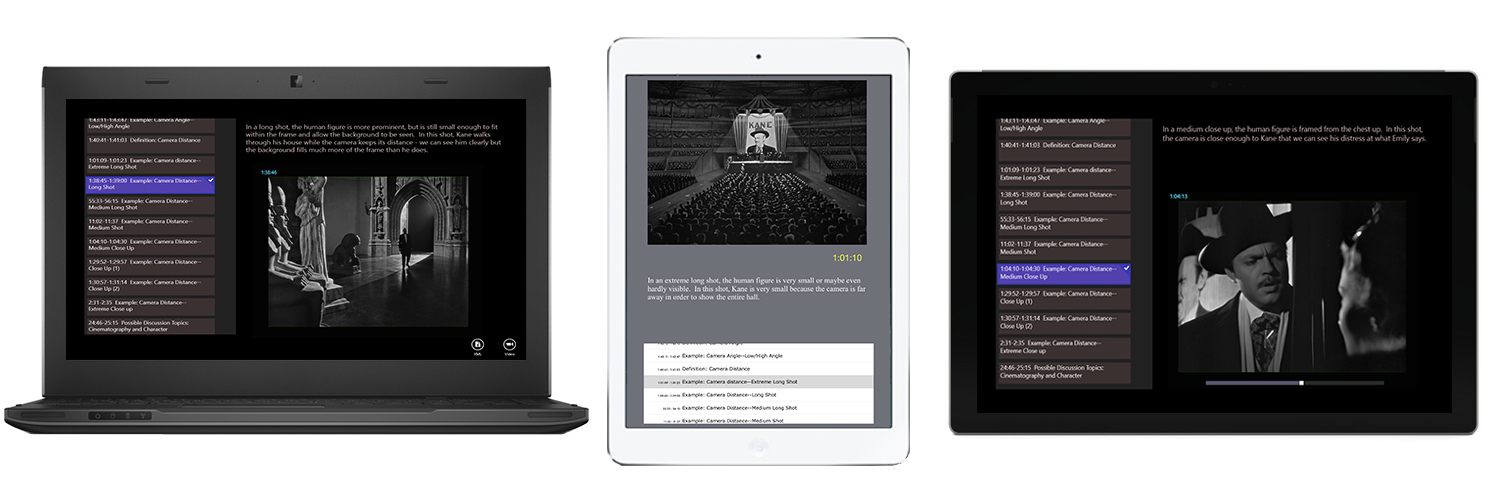You can use ClipNotes to learn and review the basics of film form, style, and analysis for FTV 6A: “History of the American Motion Picture.” The app is especially helpful for working on class papers that call for film analysis.
Detailed instructions on operating ClipNotes are available in the how-to section.
You can sign out one of 10 iPads from the Arts Library; each iPad includes films from FTV 6A. You must use your own BruinCard to check out an iPad.
Checkout Location: Arts Library Circulation Desk
Hours: See here
Checkout Period: 4 hours, with option to renew once
*Important notes:
-
Renew online by logging into your Library account at catalog.library.ucla.edu
-
The iPad must be returned to the Arts Library
-
You will be fined for any items damaged or returned late
If you have used ClipNotes for a class, such as FTV 6A or FTV 112, please fill out this form that will provide us with valuable feedback on the app.
To cite a ClipNotes file in an essay, follow the example below:
- MLA:
deWaard, Andrew. “Do the Right Thing.” Clipnotes. http://clipnotes.org/wp-content/uploads/XML/DoTheRightThing-Instructional.xml
- Chicago:
Andrew deWaard. “Do the Right Thing.” Clipnotes. http://clipnotes.org/wp-content/uploads/XML/DoTheRightThing-Instructional.xml
FTV 6A: Films and Topics Available on ClipNotes
| Film | XML File | Director | Year | File Description | Terminology and Topics Covered | XML Author |
|---|---|---|---|---|---|---|
| Casablanca | Casablanca-Instructional.xml | Michael Curtiz | 1942 | Instructional: Narrative Construction | Motivation, Motif, Plot/Story, Diegesis, Temporal Order & Duration, Exposition, Narration, Depth/Range of Information | Andrew deWaard |
| Citizen Kane | CitizenKane-Instructional.xml | Orson Welles | 1941 | Instructional: Cinematography | Deep/Shallow Focus, Deep Space, Angle, Distance (EL/L/ML/M/MCU/CU/ECU) | Bryan Wuest |
| Do The Right Thing | DoTheRightThing-Instructional.xml | Spike Lee | 1989 | Instructional: Stylistic-Thematic Analysis | Stylistic and thematic analysis of racial conflict in the film, looking at formal techniques such as doubling, long takes, motifs, and a stylized use of space | Andrew deWaard |
| Footlight Parade | FootlightParade-Instructional.xml | Lloyd Bacon | 1933 | Instructional: Gender | Spectator In The Text, Omniscient Camera, Narrative Interruption, Objectification, Objectifying Framing | Diana Dill |
| Mr. Smith Goes to Washington | MrSmithGoesToWashington-Instructional.xml | Frank Capra | 1939 | Instructional: Interpretation and Meaning | Referential Meaning, Explicit Meaning, Implicit Meaning, Symptomatic Meaning | Lindsay Giggey |
| On The Waterfront | OnTheWaterfront-Instructional.xml | Elia Kazan | 1954 | Instructional: Class and Genre | Subject vs. Theme, Labor Unions, Organized Crime, HUAC, Class and Education, Method Acting, Self-Interest Vs. Societal Interest | Mohannad Ghawanmeh |
| Psycho | Psycho-Instructional.xml | Alfred Hitchcock | 1960 | Instructional: Sound | Diegetic/Nondiegetic Sound, External/Internal, Sound Perspective, Synchronous/Asynchronous, Non-/simultaneous, On/Off-screen | Heather Birdsall |
| Singin' In The Rain | SinginInTheRain-Instructional.xml | Stanley Donen, Gene Kelly | 1952 | Instructional: Editing | Cut, Fade, Dissolve, Wipe, Graphic Match, Flashback, Overlapping Editing, Axis of Action/Center Line/180 Degree Line, Establishing Shot, Shot/Reverse Shot, Reestablishing Shot, Eyeline Match, Match on Action, Montage Sequence | Heather Birdsall |
| Stagecoach | Stagecoach-Instructional.xml | John Ford | 1939 | Instructional: Genre | Genre Conventions, Iconography | Lindsay Giggey |
| Sunrise | Sunrise-Instructional.xml | F.W. Murnau | 1927 | Instructional: Mise-en-scène | Setting, Prop, Costume, Make-Up, Staging, Lighting: Shadow (Cast/Attached), High-Key/low-Key | Bryan Wuest |
| Sunset Boulevard | SunsetBoulevard-Instructional.xml | Billy Wilder | 1950 | Instructional: Genre, Reflexivity, Lighting | Off-screen Space, Film Noir, Reflexivity, Black Comedy, Rear Projection, Low-Angle Shot, High-Angle Shot, Three-Point Lighting, Direct Address | Mohannad Ghawanmeh |
| The Best Years of Our Lives | TheBestYearsOfOurLives-Instructional.xml | William Wyler | 1946 | Instructional: Cinematography | Crane, Tracking Shot, Rack Focus, Pan, Tilt | Diana Dill |
| The Godfather | TheGodfather-Instructional.xml | Francis Ford Coppola | 1972 | Instructional: Scene Analysis | The New Hollywood, Immigration and the American Dream, Communicating Information Visually, Discretion and Secrecy, Production Design Informs About Narrative and Genre, Justice, Family and Succession to Power | Mohannad Ghawanmeh |
| The Searchers | TheSearchers-Instructional.xml | John Ford | 1956 | Instructional: Race and Representation | Racism, Systemic Racism, “The Other”, Stereotypes, “Savage”, “Squaw” vs. “Pocahontas”, “Mexican” Stereotypes, “Redskin”, Miscegenation, Manifest Destiny, Assimilation | Heather Birdsall and Karrmen Crey |
| Vertigo | Vertigo-Instructional.xml | Alfred Hitchcock | 1958 | Instructional: Editing Relations | Temporal Relations, Spatial Relations, Graphic Relations, Rhythmic Relations | Mohannad Ghawanmeh |
